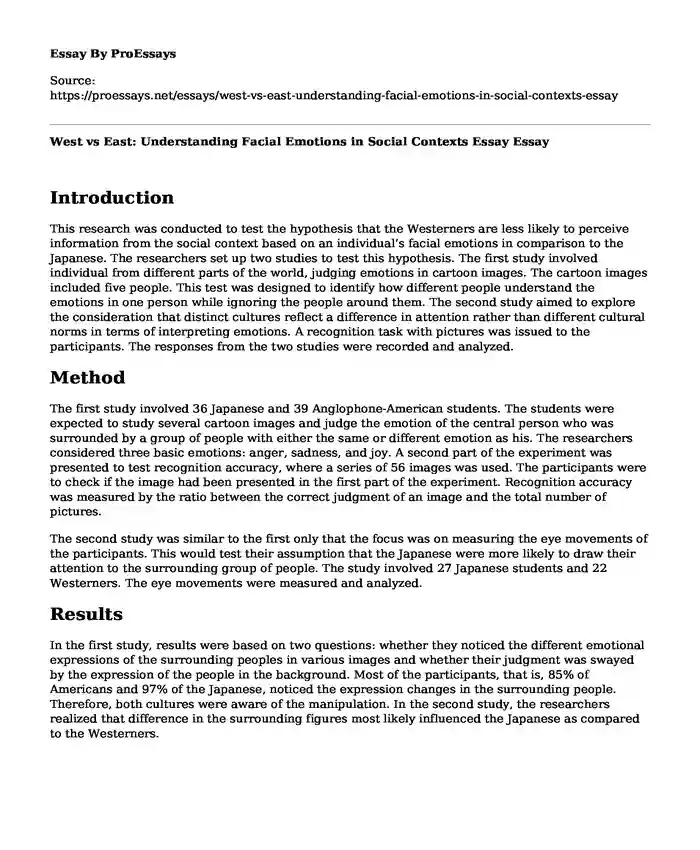Introduction
This research was conducted to test the hypothesis that the Westerners are less likely to perceive information from the social context based on an individual’s facial emotions in comparison to the Japanese. The researchers set up two studies to test this hypothesis. The first study involved individual from different parts of the world, judging emotions in cartoon images. The cartoon images included five people. This test was designed to identify how different people understand the emotions in one person while ignoring the people around them. The second study aimed to explore the consideration that distinct cultures reflect a difference in attention rather than different cultural norms in terms of interpreting emotions. A recognition task with pictures was issued to the participants. The responses from the two studies were recorded and analyzed.
Method
The first study involved 36 Japanese and 39 Anglophone-American students. The students were expected to study several cartoon images and judge the emotion of the central person who was surrounded by a group of people with either the same or different emotion as his. The researchers considered three basic emotions: anger, sadness, and joy. A second part of the experiment was presented to test recognition accuracy, where a series of 56 images was used. The participants were to check if the image had been presented in the first part of the experiment. Recognition accuracy was measured by the ratio between the correct judgment of an image and the total number of pictures.
The second study was similar to the first only that the focus was on measuring the eye movements of the participants. This would test their assumption that the Japanese were more likely to draw their attention to the surrounding group of people. The study involved 27 Japanese students and 22 Westerners. The eye movements were measured and analyzed.
Results
In the first study, results were based on two questions: whether they noticed the different emotional expressions of the surrounding peoples in various images and whether their judgment was swayed by the expression of the people in the background. Most of the participants, that is, 85% of Americans and 97% of the Japanese, noticed the expression changes in the surrounding people. Therefore, both cultures were aware of the manipulation. In the second study, the researchers realized that difference in the surrounding figures most likely influenced the Japanese as compared to the Westerners.
Discussion
Masuda et al. (2008) predicted, based on previous findings, that the Japanese pay more attention to contextual information as compared to the Westerners. Consistently, the Japanese participants, when asked to judge the emotional expressions of the central person, considered the expressions of the background figures. They considered the group as a whole before deciding how the central figure was feeling. However, the Americans judged the central person’s emotions individually despite the varying expressions of the figures around him. Cultural differences also played a role in the recognition task in the second study. Both cultures could easily identify an emotional expression on the central person that they had not seen before.
Conclusion
However, the Japanese were more alert in recognizing the changes in emotions of the background figures as compared to the Americans. The Japanese, according to the eye-tracking test, focused more on the emotions of the surrounding people than the Americans. Therefore, based on these findings, cultural differences play a significant role in the perception and understanding of emotional expressions.
Reference
Masuda, T., Ellsworth, P. C., Mesquita, B., Leu, J., Tanida, S., & Van de Veerdonk, E. (2008). Placing the face in context: cultural differences in the perception of facial emotion. Journal of personality and social psychology, 94(3), 365.https://doi.org/10.1037/0022-3514.94.3.365
Cite this page
West vs East: Understanding Facial Emotions in Social Contexts Essay. (2023, Nov 06). Retrieved from https://proessays.net/essays/west-vs-east-understanding-facial-emotions-in-social-contexts-essay
If you are the original author of this essay and no longer wish to have it published on the ProEssays website, please click below to request its removal:
- The Obesity Epidemic in America Paper Example
- Social Policy Affecting Hispanic Essay
- Gordon Allport's Trait Theory of Personality Essay Example
- Paper Example on Volunteering: Benefits for Non-Profits and Society
- Social Media Activism: Evaluating Its Effectiveness - Essay Sample
- Essay Example on Healing Racial Trauma: Kenneth V.H. on Hidden Wounds
- Free Essay on Governing a State: Ethical Dilemmas and Legal Challenges







